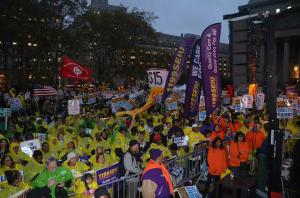
Exploited, low-wage workers, demanding a $15 an hour living wage, rallied Nov. 10 on 125th Street, the historic central artery of Harlem, and in downtown’s Foley Square. Despite the pouring rain, a rally of 100 demonstrators gathered at noon in Harlem and over 1,000 workers marched after work on Wall Street.
Early in the day, Fight for 15 protesters rallied in front of a McDonald’s in Harlem to demand an end to poverty wages and the harassment of workers who attempt to unionize. The crowd chanted, “What do we want? Fifteen! When do we want it? Now!” and “We are worth it! We are worth it!”
The crowd consisted of a cross-section of the working class, counting among its ranks restaurant workers, airport workers, adjunct professors, health care workers as well as immigrant rights groups, ant-racist organizations and the Black Lives Matter Movement.
Liberation News spoke to one KFC worker, Alvin Major, an older Caribbean-born man, who makes minimum wage. We asked him why this movement was important. “We need 15 and we need a union!” Alvin said bluntly. “They [the system] will give you $15 dollars but then they will raise the price of everything. Food will go up, housing will go up, bus fare, the transit system, and everything else will go up. It’s about the purchasing power not just the numbers. If they gave me a dollar and it could cover all these expense, then that’s what we would need. We need a living wage.”
Issues connected
Speakers at the rally connected the Fight for 15 with the fight for racial and social justice. Yari Osorio, from the ANSWER Coalition, spoke on the need to connect the issue of the wars abroad with injustice here at home: “They just announced this week that the government is going to be sending ground troops into Syria. That’s millions of dollars for war while we fight for a decent minimum wage here at home. What makes this movement powerful is that it represents workers coming together from all backgrounds. Let us not forget the workers outside of our borders who suffer from U.S imperialism. They are our allies too.”
A Palestinian mother spoke from the stage, emotionally detailing how the government deported her husband after 9/11 during one of its witch-hunts against Arabs and Muslims. She told of how she struggled alone in minimum wage jobs to try to provide her family with a decent living. Her daughter, CUNY student Aber Kawas, a young Palestinian woman with the Arab American Association and member of the organizing committee for Fight for 15, spoke with Liberation News on the connection between U.S. militarism and the Fight for a Living wage:
“Most of the people working low-wage work right now are refugees. People became refugees because U.S and Western imperialism went into other countries and caused issues there. Black people and other people in America face violence from the police. These oppressed people are forced to work minimum wage jobs. This is not just an economic issue. All of these things are connected.”
Later in the day, labor leaders and conscious youth congregated in Foley Square, 100 blocks south of Harlem, to speak on the need for a $15 minimum wage and the right to organize unions. Liberation News talked to a young activist, Justin from Black Lives Matter, who was part of a contingent that highlighted the racial inequality of pay in capitalist society. Marching with a banner that read “Black Work Matters,” Justin stated, “The struggle against racism and the struggle for working people’s rights are one in the same.”
Liberation News also spoke to Whitney, a young home health aide who works long hours taking care of seniors and chronically ill patients. When asked why she chose to attend the rally despite the inclement weather, Whitney replied: “Workers in my hospital deserve better pay no matter the weather, and in this city, where the rent keeps going up, our wages should reflect a living wage.”
Shawntaia, a food service worker, mother, and member of the youth movement 1199SEIU Purple Gold, echoed these feelings of frustration with low pay. When asked about Governor Cuomo’s announcement that he would raise public worker’s wages to $15 statewide by 2021, Shawntaia replied: “There is always going to be red tape, even if we get it [$15 minimum wage]. By the time we get it, it’s not going to be enough! I want my kids to earn a living wage and be able to stay in New York City.”
Like living in a burning home
Popular frustration with the system’s reluctance to grant workers a living wage is growing. As the late afternoon turned to evening, the sea of protesters swelled, pouring into the streets of the Wall Street financial district, the ultimate symbol of the bosses’ greed. Chants such as “Strike! Strike! Strike!” and “The roof, the roof is on fire, We need $15 because our bills are getting higher!” roared into the crisp air. The resolute worker, who came up with this chant, described how earning minimum wage and paying rent in New York City was like living in a burning home.
Home health care aids offered testimonies about the grueling hours they worked, food insecurity, poor health care, and living under the constant threat of eviction. The Wall Street investors, exiting the banks to return to their posh homes, wore concerned looks on their faces as they crossed the street to stay clear of the masses of angry workers. The worried looks on their faces portended the deep-seated changes that are in the air.





